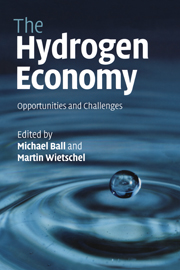Book contents
- Frontmatter
- Contents
- List of main contributors
- Preface
- Acknowledgements
- List of abbreviations
- 1 Scope of the book
- 2 Why hydrogen?
- 3 Non-renewable energy resources: fossil fuels – supply and future availability
- 4 Non-renewable energy resources: nuclear fuels
- 5 Assessment of the potentials for renewable energy sources
- 6 Carbon capture and storage
- 7 Energy-chain analysis of hydrogen and its competing alternative fuels for transport
- 8 Hydrogen today
- 9 Fundamental properties of hydrogen
- 10 Hydrogen production
- 11 Hydrogen storage
- 12 Hydrogen distribution
- 13 Key role of fuel cells
- 14 Hydrogen-infrastructure build-up in Europe
- 15 Building a hydrogen infrastructure in the USA
- 16 Hydrogen and the electricity sector
- 17 Hydrogen corridors
- 18 Macroeconomic impacts of hydrogen
- 19 Sustainable transport visions: the role of hydrogen and fuel-cell vehicle technologies
- 20 Energy-efficient solutions needed – paving the way for hydrogen
- 21 The future of hydrogen – opportunities and challenges
- Further reading
- Index
- References
12 - Hydrogen distribution
Published online by Cambridge University Press: 22 January 2010
- Frontmatter
- Contents
- List of main contributors
- Preface
- Acknowledgements
- List of abbreviations
- 1 Scope of the book
- 2 Why hydrogen?
- 3 Non-renewable energy resources: fossil fuels – supply and future availability
- 4 Non-renewable energy resources: nuclear fuels
- 5 Assessment of the potentials for renewable energy sources
- 6 Carbon capture and storage
- 7 Energy-chain analysis of hydrogen and its competing alternative fuels for transport
- 8 Hydrogen today
- 9 Fundamental properties of hydrogen
- 10 Hydrogen production
- 11 Hydrogen storage
- 12 Hydrogen distribution
- 13 Key role of fuel cells
- 14 Hydrogen-infrastructure build-up in Europe
- 15 Building a hydrogen infrastructure in the USA
- 16 Hydrogen and the electricity sector
- 17 Hydrogen corridors
- 18 Macroeconomic impacts of hydrogen
- 19 Sustainable transport visions: the role of hydrogen and fuel-cell vehicle technologies
- 20 Energy-efficient solutions needed – paving the way for hydrogen
- 21 The future of hydrogen – opportunities and challenges
- Further reading
- Index
- References
Summary
An area-wide supply of hydrogen will, in the medium to long term, require the implementation of an extensive transport and distribution infrastructure. In addition, a dense network of refuelling stations will have to be put in place. This chapter first addresses the various options for hydrogen transport and their characteristics. Subsequently, different fuelling station concepts will be discussed.
Transport options for hydrogen
Three main options are used today for hydrogen transport: delivery of compressed gaseous and liquid hydrogen by trailers and of gaseous hydrogen by pipelines. The technical and economic competitiveness of each transport option depends on transport volumes and delivery distances. As hydrogen transport costs could be considerably reduced if the existing natural gas pipeline infrastructure could be used, further possibilities under consideration are the adaptation of natural gas pipelines for hydrogen transport or the transport of hydrogen and natural gas mixtures. As for hydrogen transport by ship, so far only different concept studies have been developed.
Gaseous-hydrogen transport
Hydrogen compression
Hydrogen compression is a prerequisite for the transport of hydrogen either by pipeline or in gaseous form by trailers. The compression of hydrogen is less energy intensive than liquefaction.
- Type
- Chapter
- Information
- The Hydrogen EconomyOpportunities and Challenges, pp. 322 - 347Publisher: Cambridge University PressPrint publication year: 2009
References
- 4
- Cited by

